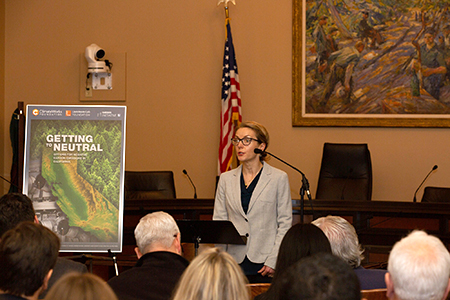New Lab report outlines ways California could reach goal of becoming carbon neutral by 2045
Lawrence Livermore National Laboratory (LLNL) scientists have identified a robust suite of technologies to help California clear the last hurdle and become carbon neutral – and ultimately carbon negative – by 2045.
This groundbreaking study, “Getting to Neutral: Options for Negative Carbon Emissions in California,” was conducted as part of LLNL’s expansive energy programs work and the Laboratory’s Carbon Initiative. The goal of the initiative is to identify solutions to enable global-scale CO2 removal from the atmosphere and hit global temperature targets.
Lawrence Livermore National Laboratory chemist Sarah Baker, lead author of the report, and other members of the team discussed the findings at a State Capitol public briefing this week. See more photos of the event.The report details a thorough assessment of the advanced carbon reduction technologies now available, their costs, as well as the tradeoffs necessary to reach the state’s decarbonization goal. The report codifies a number of significant conclusions by researchers at eight institutions. It serves as a resource for policymakers, government, academia and industry.
California executive order B-55-18 mandates that the state achieve carbon neutrality by 2045 and maintain net negative emissions thereafter. Achieving this goal would complete a chain of other ambitious statewide targets for reducing greenhouse gas emissions. The LLNL study finds that, not only is carbon neutrality possible, but that California can once again be a global climate leader by demonstrating how to remove significant amounts of CO2 from the atmosphere.
“Our findings give us confidence that this combination of negative emissions technologies and the state’s existing ambitions put the finish line in reach for California,” said Roger Aines, LLNL’s Energy Program chief scientist and the lead on the project. “The report’s findings also indicate we could become carbon neutral sooner than anticipated, at a cost less than expected, while boosting California’s economy and creating quality jobs in areas such as the Central Valley. Important co-benefits to air quality and wildfire prevention also will bring welcome relief to our state.”
Carbon neutrality refers to achieving net-zero carbon dioxide emissions by balancing any remaining atmospheric emissions with removal of carbon dioxide from the air, or simply by eliminating carbon emissions altogether. It applies to everything that generates greenhouse gases.
In the report, funded by the Livermore Lab Foundation (LLF) with grant support from the ClimateWorks Foundation, LLNL focused on three specific pillars of negative emissions: natural and working lands, carbon capture from waste biomass utilization and direct air capture. The team identified a portfolio of approaches for achieving greater than 125 million tons per year of negative emissions for California by 2045 and evaluated the scope of state and private investment to best achieve the goal.
“Without CO2 removal, reaching our carbon neutrality goal will be slower, more difficult and costly,” said LLNL chemist Sarah Baker, lead author of the report. “While there are no silver bullets, we have evaluated strategies that rely on many existing technologies and resources, creating a CO2 removal blueprint that can be replicated.”
“Climate change is the defining issue of our time. From shifting weather patterns that threaten food production to rising sea levels that increase the risk of catastrophic flooding, the impacts of climate change are global and unprecedented,” said Dona Crawford, Livermore Lab Foundation board chair. “We are grateful and proud to have worked with the ClimateWorks Foundation to support this important research and we hope it will serve as a defining guide for action.”
About LLNL
Founded in 1952, Lawrence Livermore National Laboratory provides solutions to our nation’s most important national security challenges through innovative science, engineering and technology. Lawrence Livermore National Laboratory is managed by Lawrence Livermore National Security, LLC for the U.S. Department of Energy's National Nuclear Security Administration.
About LLF
The Livermore Lab Foundation is a 501(c)(3) nonprofit organization created in 2016 to advance scientific knowledge and inspire next-generation scientists and engineers. The foundation carries out its mission by seeking philanthropic contributions to support scientific education, research and innovation at Lawrence Livermore National Laboratory. For more information, visit the web.
About ClimateWorks
ClimateWorks helps foundations and climate leaders come together to be more strategic, efficient and effective in their response to global climate change. We are a collaborative team of researchers, strategists and grant-makers committed to our mission of mobilizing philanthropy to solve the climate crisis and ensure a prosperous future for all. Since 2008, ClimateWorks has provided $1 billion in grants to organizations around the world focused on solving climate change. For more information about our programs, grant-making and partnerships, visit the web.
Contact
 Anne M. Stark
Anne M. Stark
[email protected]
(925) 422-9799
Related Links
Getting to Neutral: Options for Negative Carbon Emissions in CaliforniaExecutive Summary
ClimateWorks Foundation
Livermore Lab Foundation
Tags
Global SecurityPhysical and Life Sciences
Featured Articles









